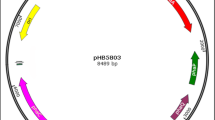Abstract
Extracting polyhydroxyalkanoate (PHA) polymer from bacterial cells often involves harsh conditions, including use of environmentally harmful solvents. We evaluated different detergents under various conditions to extract PHA from Ralstonia eutropha and Escherichia coli cells. Most detergents tested recovered highly pure PHA polymer from cells in amounts that depended on the percentage of polymer present in the cell. Detergents such as linear alkylbenzene sulfonic acid (LAS-99) produced a high yield of high purity polymer, and less detergent was needed compared to the amount of SDS to produce comparable yields. LAS-99 also has the advantage of being biodegradable and environmentally safe. Chemical extraction of PHA with detergents could potentially minimize or eliminate the need to use harsh organic solvents, thus making industrial PHA production a cleaner technology process.




Similar content being viewed by others
References
Anderson AJ, Dawes EA (1990) Occurrence, metabolism, metabolic role, and industrial uses of bacterial polyhydroxyalkanoates. Microbiol Rev 54:450–472
Choi JI, Lee SY (1999) Efficient and economical recovery of poly(3-hydroxybutyrate) from recombinant Escherichia coli by simple digestion with chemicals. Biotechnol Bioeng 62:546–553
Doi Y, Kitamura S, Abe H (1995) Microbial synthesis and characterization of poly(3-hydroxybutyrate-co-3-hydroxyhexanoate). Macromolecules 28:4822–4828
Ibrahim MH, Steinbüchel A (2009) Poly(3-hydroxybutyrate) production from glycerol by Zobellella denitrificans MW1 via high-cell-density fed-batch fermentation and simplified solvent extraction. Appl Environ Microbiol 75:6222–6231
Jendrossek D, Handrick R (2002) Microbial degradation of polyhydroxyalkanoates. Ann Rev Microbiol 56:403–432
Jensen J (1999) Fate and effects of linear alkylbenzene sulphonates (LAS) in the terrestrial environment. Sci Total Environ 226:93–111
Jiang X, Ramsay JA, Ramsay BA (2006) Acetone extraction of mcl-PHA from Pseudomonas putida KT2440. J Microbiol Methods 67:212–219
Khanna S, Srivastava AK (2005) A simple structured mathematical model for biopolymer (PHB) production. Biotechnol Prog 21:830–838
Madison LL, Huisman GW (1999) Metabolic engineering of poly(3-hydroxyalkanoates): from DNA to plastic. Microbiol Mol Biol Rev 63:21–53
Mergaert J, Anderson C, Wouters A, Swings J, Kersters K (1992) Biodegradation of polyhydroxyalkanoates. FEMS Microbiol Rev 9:317–321
Mieure JP, Waters J, Holt MS, Matthjis E (1990) Terrestrial safety assessment of linear alkylbenzene sulfonate. Chemosphere 21:251–262
Scott MJ, Jones MN (2000) The biodegradation of surfactants in the environment. Biochim Biophys Acta 1508:235–251
Steinbüchel A, Fuchtenbusch B (1998) Bacterial and other biological systems for polyester production. Trends Biotechnol 16:419–427
Sudesh K, Abe H, Doi Y (2000) Synthesis, structure and properties of polyhydroxyalkanoates: biological polyesters. Prog Polym Sci 25:1503–1555
Thakor N, Lutke-Eversloh T, Steinbüchel A (2005) Application of the BPEC pathway for large-scale biotechnological production of poly(3-mercaptopropionate) by recombinant Escherichia coli, including a novel in situ isolation method. Appl Environ Microbiol 71:835–841
Yang YH, Brigham CJ, Budde CF, Boccazzi P, Willis LB, Hassan MA, Yusof ZA, Rha C, Sinskey AJ (2010) Optimization of growth media components for polyhydroxyalkanoate (PHA) production from organic acids by Ralstonia eutropha. Appl Microbiol Biotechnol 87:2037–2045
Zhang Y, Praszkier J, Hodgson A, Pittard AJ (1994) Molecular analysis and characterization of a broad-host-range plasmid, pEP2. J Bacteriol 176:5718–5728
Acknowledgments
The authors thank Mr. John Quimby and Ms. Karen Pepper for their contributions to this manuscript. This work was supported by a grant from the government of Malaysia and the Malaysian Office of Science, Technology and Innovation (MOSTI). The result of this grant, the Malaysia-MIT Biotechnology Partnership Program (MMBPP), is a collaboration between MIT, SIRIM Berhad, Universiti Putra Malaysia, and Universiti Sains Malaysia. The authors would like to thank the members of this program for their collegial collaborations.
Author information
Authors and Affiliations
Corresponding author
Electronic supplementary material
Below is the link to the electronic supplementary material.
Rights and permissions
About this article
Cite this article
Yang, YH., Brigham, C., Willis, L. et al. Improved detergent-based recovery of polyhydroxyalkanoates (PHAs). Biotechnol Lett 33, 937–942 (2011). https://doi.org/10.1007/s10529-010-0513-4
Received:
Accepted:
Published:
Issue Date:
DOI: https://doi.org/10.1007/s10529-010-0513-4




